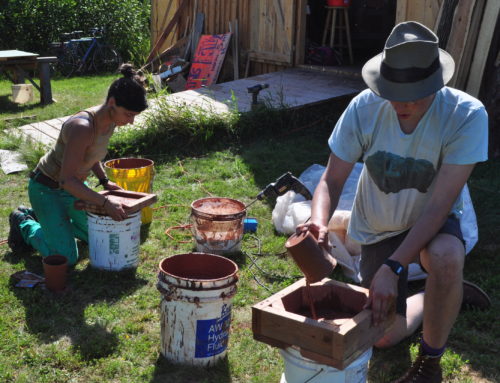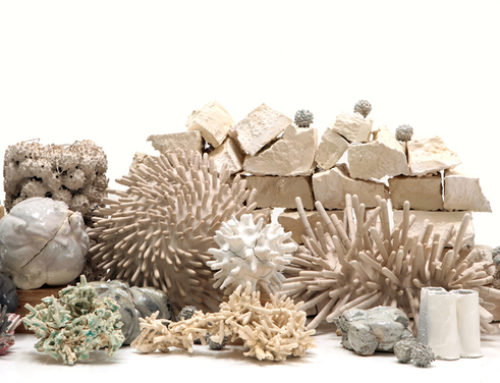Emotional sustainability, as I define it, is the ability of an object to maintain perpetual relevance through how we understand the meaning of the object. In short, how we treat an object is dependent on how we feel about or understand an object.
For example: my mother is a “sentimental” person – and will keep old gloves from her great-grandmother that are practically falling apart because of her emotional attachment to them.
The physical aspects of environmental sustainability are usually the first things considered when talking about “green” ceramics. Proponents of environmentalism in ceramics are open to sharing knowledge and interested in the latest technology that makes the studio practice more efficient and earth-friendly. However, I have also heard skeptics say that ceramicists only use a nominal amount of energy compared to other industries, that our energy consumption is only a “drop in the bucket” in the world-wide basin of pollution. This may be true, however, a majority of ceramicists remain reliant on industry to fulfill their needs. This hypocrisy got me to thinking about the conceptual side of sustainability – and prompted some research into how the emotional value of an object influences sustainability.
In an increasingly capitalistic consumer culture, many decisions are made about where the materials for products come from, how the products are manufactured, and what expenditures will be made on behalf of the consumer versus the environmental costs of production. Oftentimes these considerations in addition to aesthetic characteristics add to the “emotional value” of an object. It is a well-known concept to potters who may have explained to a consumer why their product is priced higher than a ceramic mug from Wal-Mart. This clip from Portlandia is maybe a stretch – but it stems from something so true about what people value! What many ceramicists have to their advantage is the uniqueness afforded by hand-making their wares and spending time on design. From a standpoint of economics, emotional sustainability is something an artist can provide to consumers. And, if a consumer has a sentimental attachment to a product, they are less likely to view the object as disposable (therefore decreasing a widespread problem of environmental efforts). What I urge from the readers is to not only look at the environmental impacts produced from physical manufacturing, but also look at what sort of mentality fuels production. Environmentalism is more than “going green” in physical efforts, and proponents of the movement may even stifle their efforts in not considering the holistic approach to what sustainability is.
I have identified a few ceramic artists here that use the idea of emotional sustainability in various ways (which goes hand in hand with environmental sustainability). Please comment with thoughts, ideas, or other artists to add to the conversation.
“Nothing is thrown away. This immigrant lives in fear of waste. Old yogurt is used to jumpstart the new batch. What is worth risking for things to get juicy, rare, ripe? What might be discovered on the verge of things going bad?”
Sormin values how the physical can be re-contextualized by words and emotion.
“Daily used products or found materials get a different look by making a small interference. Inspiration comes from her working experience, travelling and experiences using the screenprint technique in any possible way and on any possible material.”
Dirkx’s work also benefits from a reframing of the physical. She is re-using, which is environmentally and economically sustainable – and consequently will cause consumers to value the wares.
“Artist-in-Residence Richard Bresnahan and the Saint John’s Pottery engage students, apprentices, and visiting artists in the work of artistic creation, discipline, and research and preparation of natural materials. These dynamic experiences are framed by questions of what it means to envision and create a sustainable lived system.”
Bresnahan basically works in a closed system of creating his own glazes, clay, and wood for firing. His pots may look similar to those made my someone else, but the fact his wares are imbued with a spirituality of sustainable practice is what gives them unique value.







[…] In an increasingly capitalistic consumer culture, many decisions are made about where the materials for products come from, how the products are manufactured, and what expenditures will be made on behalf of the consumer versus the environmental costs of production. Oftentimes these considerations in addition to aesthetic characteristics add to the “emotional value” of an object. It is a well-known concept to potters who may have explained to a consumer why their product is priced higher than a ceramic mug from Wal-Mart. This clip from Portlandia is maybe a stretch – but it stems from something so true about what people value! What many ceramicists have to their advantage is the uniqueness afforded by hand-making their wares and spending time on design. From a standpoint of economics, emotional sustainability is something an artist can provide to consumers. And, if a consumer has a sentimental attachment to a product, they are less likely to view the object as disposable (therefore decreasing a widespread problem of environmental efforts).” Maret Miller, from the NCECA Green Task Force blog […]
While its true that “if a consumer has a sentimental attachment to a product, they are less likely to view the object as disposable (therefore decreasing a widespread problem of environmental efforts)”, you can also argue that disposability is just the opposite side of the problem from acquisitiveness. Sure, we keep the things we care about longer, but we also keep far more things than we actually need.
For every mug that is tossed away as disposable there are plenty sitting unused in cupboards and on shelves. I’m sure I personally have something like 200 handmade mugs in my kitchen collection, but I can only use 3 or 4 each day. And that only turns out to be the same 3 or 4 each and every day, with few exceptions. Do I really NEED those other ones? How can I justify my gluttony? Sentimentality drives me to find more and more mugs I like but will never fully use……
So, while sentimentality will keep things out of dumpsters and landfills, it also encourages us to hoard far more than we typically need. Its not always a positive force in the world. Its a double edged sword at the very least.
Another problem I also see is that sentimentality attaches to the most peculiar things. For instance, there is emotional sustainability attached to guns, to hatred and prejudice, to greed, to getting the better of the competition and winning the rat race…. All these things have an emotional endurance, yet they are rarely qualities that provide for global health. The bitter truth is that what makes things work emotionally for one person can be at odds with the things that work for the larger aggregates of the community. Sentimentality can also be abused and exploited for extraneous purposes (think advertising).
Sentimentality as a generic measure of value just seems questionable. Its not a necessary ecological value in and of itself. As a human motive it has both its good and bad points. And by reflecting the range of possible human attachments it also bears scrutiny. We are far too sentimental about harmful and divisive things. If sentimentality has advantages those are perhaps entirely due to the things we are sentimental about, but also to how we use this to move forward in the world. The objects themselves need independent value, and the human culture surrounding them needs to have merit for its own or other reasons. The fact of sentimentality tells us nothing about the ‘good’ of the things it is attached to…..